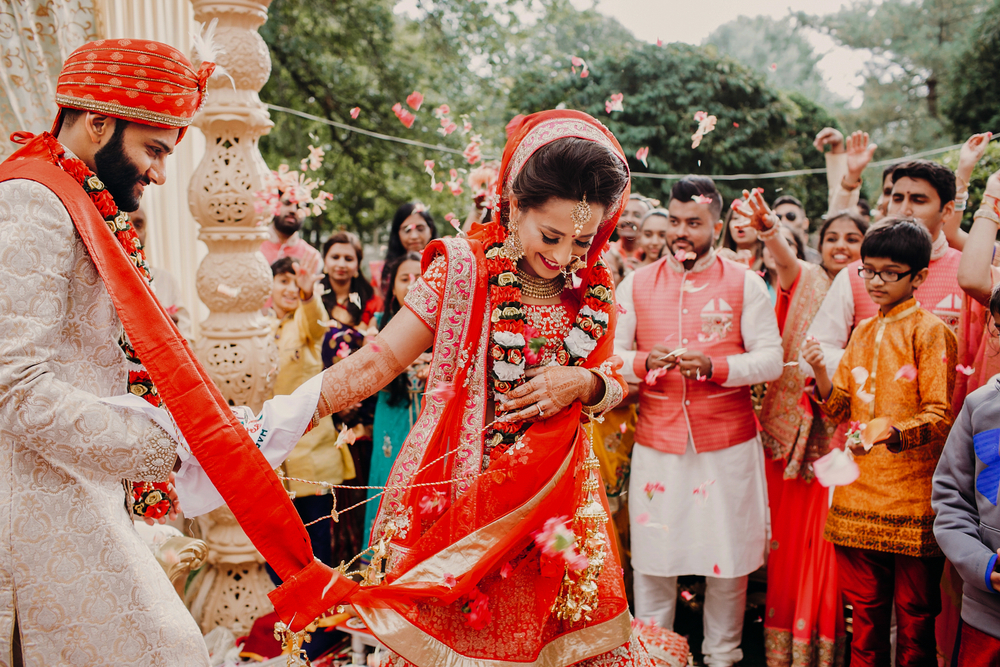Are You Aware of These Significant Hindu Wedding Traditions?

A Hindu wedding is primarily a Vedic yajna ritual, with three important ceremonies that are practically universal. No wedding is complete without Kanyadan, Panigrahana, and Saptapadi. The wedding is a lovely occasion to celebrate heritage. Even if only a few of these many proposals are in preparation. Modern couples frequently choose to personalise their marriage.
Table of Contents
Listed below are the significant wedding rituals you should be aware of
Muhurat
Mahurat translates as “time.” In a Hindi matrimonial, wishes and sweets are given out after the introduction of the two families.
The timing of the wedding ceremony, or the “mahurat,” is crucial for them to determine. Based on the date and time, they can then plan other events like Haldi, mehndi, and Sangeet. The calculations for the date and time are typically done by an astrologer or “Pandit”. The choice of an auspicious Muhurat to begin the wedding is also made.
Roka or Tilak Ceremony
The Roka or Tilak Ceremony usually comes after the mahurat. And approved as the next stage of the celebration.
After a quick puja, the bride and groom receive blessings from their elders. The future bride wears a crimson chunni or veil, and the couple receives gifts from both sides of the family. While many choose a separate ring ceremony, the couple does swap rings.
Barni Bandhwana
The Barni Bandhwana occurs 15 days before the Hindi marriage ceremony. The groom’s family ties the Mauli, or red thread, around his wrist. The purpose of this practice is to ward off any bad omens and to pray for his safety.
Mehendi Ceremony
The Mehndi ceremony is the first ritual that takes place after the wedding festivities. The bride has henna put on her hands and feet, covering her hands up to her elbows.
Drawings of mehendi patterns with floral and geometric patterns, lines, and many motifs are used. The closer a bride feels to her groom, the darker her mehndi pattern appears.
Sangeet Night
The Sangeet night is the most thrilling part of the wedding. The bride and groom’s family mix and dance all night long during this celebration.
It’s the ideal way to let go of the stress of wedding planning while unwinding, relaxing, and spending time with your loved ones.
Haldi
The haldi ceremony, which takes place as the final event before the wedding, is a crucial event. Before their wedding, the couple takes part in the Haldi ceremony, during which their relatives get together to cover them with oil, water, and turmeric.
The mixture is applied to the couple’s skin and clothing all over and is believed to bless them. The bride and groom’s vivacious glow from the haldi is a bonus of the event. It can take place the day before the wedding or even the morning of.
Baraat
The wedding ceremonies themselves officially begin with the raising of the Baraat.
After a little puja, the groom climbs up a horse. And travels to the location of the wedding with his family, friends, and, of course, a group of dhol players.
The groom’s entrance inside the altar is referred to as the Baraat. The Baraat, which resembles a small festival in and of itself, is a time when everyone dances to the beat of the dhol.
Milni
The meeting is what Milni means. The bride’s family welcomes the Baraat after it has arrived, and then a little ceremony is carried out. With embraces, garlands, and tikas, the bride’s side welcomes the groom’s side into her home or the wedding venue. As a sign of welcome and respect, gifts and sweets are also exchanged.
Bride’s Entry
The bride’s entry at any wedding is a poignant and wonderful event. In Hindu wedding traditions, the goddess Laxmi is linked to the bride. The bridegroom’s house welcomes her with a lot of respect and good fortune.
The bridal entry is handled differently in every town. In some, the bride walks toward the mandap while passing beneath a phoolon-ki-chadar or a crimson chunni after entering the church with her father or brother.
Jaimala
At the altar, the bride and groom ultimately exchange garlands. A var mala or Jai mala is an Indian wedding garland that represents the well-liked wedding ritual.
The garlands, also known as Jaimalas, are of flowers and are available in a variety of patterns and flowers. Involved in every Hindi matrimony ritual is the var mala or jai mala, a fresh floral bridal garland.
Kanyadaan
The kanyadaan rite in a wedding ceremony is one of the most emotional times in a woman’s and her parents’ lives.
The Sanskrit term “kanyadaan” means “giving the daughter away.” And as the name implies, it refers to the custom or rite in which parents present their daughter to the bride.
Hawan
A sacrifice fire ceremony called “Havan,” also called “Homa,” is carried out in a square “Kunda” or bilaterally symmetrical altar. The ‘Vivaha Havan’ is done throughout this ritual to foster a sense of holiness and divinity.
The bride and groom exchange their holy vows to one another and the Gods and perform their marriage ceremonies in front of the Agni as a witness. The bride and groom are sits facing east around the fire. Before they take the seven pheras, the bride and groom join hands, make sacrifices to the sacrificial fire, and chant holy songs.
Pheras
The bride and groom proceed to the pheras after the chanting and hymns have been recited. One of the most significant aspects of the Hindu wedding ceremony is the saat phere. Seven times are made around a sacred fire that has been set for the occasion while chanting Vedic mantras.
The bride and groom take seven steps, known as Saptapadi. After that, the groom ties the bride’s mangalsutra around her neck and applies sindoor on her forehead. Soon as the pair takes their seventh step and are then legally wed.
Joota Chupai Rasam
Indian marital traditions like the Joota Chupai Rasam have been around for a while.
The siblings, cousins, and friends from both sides of the spouse take part in this entertaining tradition. The groom has to give the bride’s side whatever they request in exchange for the shoes. The shoes are intended to take and hide until the ceremony is through.
The groom’s secondary responsibility is to look after the shoes. And find them if they are stolen before the wedding. It’s an entertaining ritual, and the kids can even participate in it while the main ceremony is going on.
Bidaai
When the ceremony is over, it’s time for the bride to say goodbye to her family and head to her new home. It is the most poignant and melancholy moment of the entire wedding. The Bidaai ceremony bids the daughter of the house a fond farewell from her parents’ home and bestows blessings on the forthcoming fresh beginnings.
Hindu wedding rituals and traditions are rich, vibrant, and deeply rooted in culture. While they may vary depending on the community, the fundamental guidelines and rituals remain largely the same. Couples today are also very conscious of their ancient customs while also adopting or changing some rituals that are more appropriate for the moment and era.





